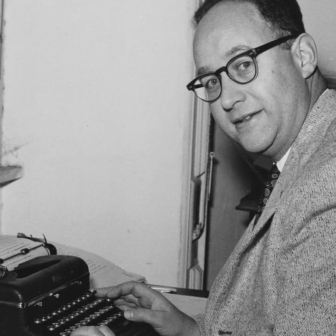As a child, William Empson was a maths prodigy. He won a scholarship to study at Cambridge in 1924 and was awarded the Magdalen College prize in his first set of exams. Then came the first swerve. He greatly upset his tutors by switching from maths to English literature, took to acting in undergraduate theatre productions, edited an avant-garde magazine, and proceeded to get first-class honours with distinction in the final exams for literature.
After he was awarded a college teaching fellowship, the second swerve came. The college scout who cleaned his rooms found a condom under the bed, and reported it. Heterosexual activity in college rooms was, at the time, the gravest of misdemeanours. At an extraordinary meeting of the governing body of Magdalen, Empson was stripped of his fellowship and, effectively, was out on his ear. For the next two years, he lived in London as a fringe dweller of the Bloomsbury group, finishing his first book, Seven Types of Ambiguity, which was published in 1930, when he was just twenty-four years old.
There were many more swerves to come. Empson taught in Japan and wrote a book about Buddhist sculptures, worked alongside George Orwell at the BBC during the second world war, was living in Peking at the time of the communist siege, and witnessed the triumphal entry of Mao into the fallen city.
The story of William Empson’s life would make a great TV series. Perhaps not for our ABC – it is not an Australian story, after all, though in later life, when he was professor of literature in Sheffield, Empson insisted on the importance of keeping “a certain world-mindedness” in literary culture.
What has arrived on our screens, by virtue of a couple of odd swerves on the literary scene, is the current ABC television series Seven Types of Ambiguity, based on the 2003 novel of that title by Elliot Perlman. Perlman makes it into an Australian story, featuring a dog named Empson and a central character who possesses a well-thumbed copy of Empson’s book.
Empson offered a study of ambiguities in literary language. Perlman is interested in the challenges of interpreting human personality and behaviour; the seven types of ambiguity in his novel correlate with the perspectives of seven different people involved in a critical incident. Events revolve around Simon, a man in his early thirties whose life has fallen into a morass of depression, unemployment and broken relationships. Those around him don’t know how to read him, and when he abducts a six-year-old boy, the interpretation of his motives also becomes a matter for the courts.
In Perlman’s narrative, this incident is recounted at one remove through a report by Alex, a psychologist who sets the case in the context of Simon’s prehistory as a schoolteacher who took a special interest in helping children with difficulties. But that story also includes an obsessive former relationship with the child’s mother, and the fact that one of the children previously befriended by Simon was also abducted.
It’s a promising scenario for a television drama: a central line of suspense; a compelling psychological enigma that draws the characters into an inflamed sequence of conflicts; and a tight structural cohesion in a delimited set of characters and relationships. The lure to producers is obvious.
Producers, though, should beware of obvious lures. Sometimes, contrary to their assumptions, audiences get weary of being served up with the ingredients that production teams have determined they must want. Where Perlman’s novel adopts structural conventions that manage the tensions with a certain narrative distance, this television adaptation pitches us into the midst of them, tracking the unfolding scenes immediately before and after the child, Sam, is found to be missing.
This first episode takes the point of view of Sam’s father, Joe (Alex Dimitriades), a stockbroker preoccupied with a shady deal involving a bent politician. One of Joe’s business perks is entertainment, provided in a high-class brothel. As his story unfolds, the tensions in his marriage, his illicit sex life and his deal-making all come to a good rolling boil.
Through the ensuing five episodes, the other key participants are shown in equally intense forms of personal turmoil. There is Alex the psychologist (Hugo Weaving), Gina the lawyer (Susie Porter), Simon’s friend Angela (Andrea Demetriades), Joe’s business partner Mitch (Anthony Hayes), and Sam’s mother Anna (Leeanna Walsman). Simon (Xavier Samuel), as the “seventh type,” features centrally in all of them.
For a novelist, going over the same sequence of events from several different perspectives is a technical challenge to be met through changes of focus and narrative voice. In television, repeated footage is repeated footage, even if the camera angles change or the scripting is differently edited. This means the episodes must engage more fully in the personal storylines of the six characters, filling out the details of their own relationships.
As we are drawn successively into the stories of Joe, Alex, Gina, Angela and Mitch, the emotional overload becomes suffocating. Rows break out in every scene; every shot seems to be a close-up of someone tearing up or letting rip. Director of photography Bonnie Elliott has worked with some ingenuity to vary the visual composition, but the core business of the series is in the reaction shots. We’re always, quite literally, in someone’s face.
This, and the overblown emotional tenor of the series as a whole, is typical of a certain house style in ABC drama. Several key people in the cast and production team for Seven Types of Ambiguity (including Alex Dimitriades and producers Tony Ayres and Matthew Seville) were also involved in The Slap (2011), another “relationship drama” revolving around a delimited group of people drawn into crisis by a single incident. Both series are, essentially, suburban melodramas dealing with people whose lives seem to be all about themselves.
Drama series are expensive, and for the ABC, in its current embattled state, the stakes are high. Failure would be costly in more than financial terms, and perhaps there is just too much determination to force a success. The broadcaster’s habit of promoting new series as “acclaimed” before the first episode has even gone to air is symptomatic.
There’s no pleasure in dissenting from the acclamation. The series will doubtless appeal to a fair number of viewers. It has a strong cast, and the narrative tension in the central storyline holds up to the end. But accentuating the positive is just avoiding the issue. There are problems here. The pace is leaden, the mood is ponderous. The characters are predictable and their interactions are relentlessly over-explicit. Ambiguity, which requires a certain breathing space, has gone AWOL.
Ultimately this is a claustrophobic, inward-looking dramatic world. In making use of Empson’s title, the production team might have paid at least some heed to his work and his influence. “To become morally independent of one’s formative society is the grandest theme of all literature, because it is the only means of moral progress,” as he once said. That was the statement of someone who had lived through violent conflicts in three different parts of the world and been on the front line in the propaganda wars, but what he meant by “moral independence” was more than a matter of cognitive dissent from political propaganda.
Total immersion in one’s own cultural milieu is itself a form of brainwashing. Empson’s call for “world-mindedness” is as urgently relevant now as it was in any of the times of international upheaval through which he lived. His Seven Types of Ambiguity revolutionised how literature was taught in the Anglophone world by focusing on a training in the precise observation of language – the kind of precision that a mathematician might bring to the modelling of a problem was shown to apply to the study of poetry.
The most compelling dramas, whether for television, theatre or cinema, manage to combine the expansive qualities of world-mindedness with the more clinical disciplines of precision and emotional restraint. Producers at the ABC need to understand this before they make their next bid for acclaim. •




